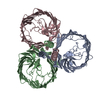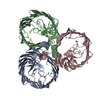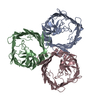+Search query
-Structure paper
| Title | Dual function of OmpM as outer membrane tether and nutrient uptake channel in diderm Firmicutes. |
|---|---|
| Journal, issue, pages | Nat Commun, Vol. 14, Issue 1, Page 7152, Year 2023 |
| Publish date | Nov 6, 2023 |
 Authors Authors | Augustinas Silale / Yiling Zhu / Jerzy Witwinowski / Robert E Smith / Kahlan E Newman / Satya P Bhamidimarri / Arnaud Baslé / Syma Khalid / Christophe Beloin / Simonetta Gribaldo / Bert van den Berg /   |
| PubMed Abstract | The outer membrane (OM) in diderm, or Gram-negative, bacteria must be tethered to peptidoglycan for mechanical stability and to maintain cell morphology. Most diderm phyla from the Terrabacteria ...The outer membrane (OM) in diderm, or Gram-negative, bacteria must be tethered to peptidoglycan for mechanical stability and to maintain cell morphology. Most diderm phyla from the Terrabacteria group have recently been shown to lack well-characterised OM attachment systems, but instead have OmpM, which could represent an ancestral tethering system in bacteria. Here, we have determined the structure of the most abundant OmpM protein from Veillonella parvula (diderm Firmicutes) by single particle cryogenic electron microscopy. We also characterised the channel properties of the transmembrane β-barrel of OmpM and investigated the structure and PG-binding properties of its periplasmic stalk region. Our results show that OM tethering and nutrient acquisition are genetically linked in V. parvula, and probably other diderm Terrabacteria. This dual function of OmpM may have played a role in the loss of the OM in ancestral bacteria and the emergence of monoderm bacterial lineages. |
 External links External links |  Nat Commun / Nat Commun /  PubMed:37932269 / PubMed:37932269 /  PubMed Central PubMed Central |
| Methods | EM (single particle) / X-ray diffraction |
| Resolution | 1.7 - 3.28 Å |
| Structure data | EMDB-16328, PDB-8bym: EMDB-16332, PDB-8bys: EMDB-16333, PDB-8byt:  PDB-8bz2: |
| Chemicals |  ChemComp-SO4:  ChemComp-HOH: |
| Source |
|
 Keywords Keywords |  MEMBRANE PROTEIN / MEMBRANE PROTEIN /  Porin / outer membrane / attachment / peptidoglycan-binding / Outer membrane attachment / nutrient transport / Porin / outer membrane / attachment / peptidoglycan-binding / Outer membrane attachment / nutrient transport /  STRUCTURAL PROTEIN STRUCTURAL PROTEIN |
 Movie
Movie Controller
Controller Structure viewers
Structure viewers About Yorodumi Papers
About Yorodumi Papers










